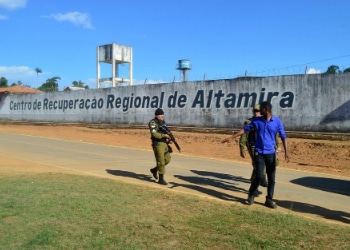A gruesome prison massacre in northern Brazil has raised serious questions about potential shifts in criminal alliances in a highly strategic region of this South American nation.
As many as 57 inmates were killed in the worst prison massacre recorded so far in 2019 after fighting broke out between rival criminals gangs at the Altamira prison in Brazil’s northern Pará state on July 29, the country’s Justice and Public Security Ministry announced in a press release.
A local gang identified as the Class A Command (Comando Classe A — CCA) reportedly stormed a wing of the prison controlled by rivals in the Red Command (Comando Vermelho) as part of a broader war over control of the lucrative drug trade in Brazil’s Amazon. Gang members set fire to mattresses and decapitated at least 16 prisoners, according to local reports.
The prison riot was a “settling of scores between the two factions,” Pará’s prison director Jarbas Vasconcelos told local reporters from Agência Pará. He added that his team “had no [prior] information about an attack of this magnitude.”
However, Carlos André Costa, the deputy secretary of intelligence and criminal analysis in Pará, told Folha de São Paulo that authorities had obtained intelligence earlier in the month indicating that outside elements of the Red Command were driving south into areas controlled by the First Capital Command (Primeiro Comando da Capital – PCC) in Pará, suggesting that a potential war was brewing.
The CCA’s involvement in the massacre stems from its apparent alliance with the much more powerful PCC.
SEE ALSO: InDepth Coverage of Prisons
The lesser known CCA was formed in 2013 by Oziel Barbosa, a drug dealer who went by the alias “Maranhão,” according to Época Magazine. Barbosa was later killed in 2016, but the CCA has reportedly remained strong within Pará’s prison system.
Following the massacre, authorities transferred 46 prisoners accused of partaking in the carnage. Ten prisoners were taken to federal facilities outside of Pará, while the remaining 36 will be redistributed to other prisons within the state.
This isn’t the first deadly slaughter linked to warring criminal gangs to rock Brazil’s prison system.
A 2017 New Year’s Day massacre in the Amazon city of Manaus left 56 inmates dead. The fight was linked to a feud between the Family of the North (Família do Norte – FDN) and the PCC over the Amazon region’s drug trade. Another 33 prisoners were killed four days later in retaliation during a prison riot in neighboring Roraima state.
The sheer scale of mass incarceration in Brazil facilitates such gang violence. As of the end of June 2018, Pará state’s 47 prisons held about 16,500 prisoners, despite only having the capacity to hold around 8,600 inmates, according to official Susipe data. More than 340 prisoners were housed at Altamira prison at the time of the massacre, double its capacity of just 163 inmates, according to Folha de São Paulo.
InSight Crime Analysis
The São Paulo-based PCC, one of Brazil’s most formidable criminal groups alongside the Rio de Janeiro-based Red Command, has in recent years expanded into Brazil’s northern Amazon region using extreme violence, with the goal of controlling the highly profitable drug trade there. The latest prison massacre appears to be linked to these efforts.
After the collapse in early 2017 of a longstanding truce between the PCC and Red Command, the PCC reportedly joined forces with the Guardians of the State (Guardiões do Estado – GDE) while the Red Command allied itself with the Family of the North, both smaller criminal organizations operating in Brazil’s prized northern region.
However, these alliances appear to have cracked. Since then, the CCA has allied itself with the PCC, according to reports from Folha de São Paulo.
In Pará, however, the Red Command and PCC reportedly had a tacit non-aggression agreement up until earlier this year. The Red Command controlled the city of Belém and cocaine trafficking routes coming into Brazil from Colombia and Peru along the Amazon river, while the PCC controlled Pará’s interior.
Yet when the Red Command started moving south into areas under the PCC’s control, the latter clearly wanted to send a message in the form of the prison massacre. What’s more, a video obtained by authorities earlier this year showed two suspected Red Command leaders murdering a rival PCC leader in a small Pará town, hinting that an underlying war was taking shape.
“This [Pará state] is ours, all of it,” the Red Command members said.
SEE ALSO: Brazil News and Profiles
Northern Pará state is home to the port city of Belém, one of the main smuggling routes used for cocaine coming into Brazil from Peru and Colombia — two of the world’s top producers of the drug. The cocaine is partly destined for drug sales in Rio de Janeiro and São Paulo, where Brazil has a booming consumer market.
The recent prison massacre is likely “part of the larger scramble for control of Brazil’s north and northeast,” according to Benjamin Lessing, a professor at the University of Chicago who examines organized crime in Brazil.
“The CCA took an opportunity to strike against the Red Command in a brutal way that suggests it is trying to intimidate rivals and establish its bona fides,” Lessing told InSight Crime. “Several unverified reports suggest [the CCA] has become an ally of the PCC, so it may have acted at the PCC’s urging, or as a way of getting in good with the PCC.”

